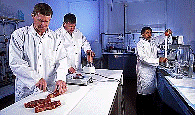United States Department of Agriculture: Agricultural Research Service, Lincoln, Nebraska

Roman L. Hruska U.S. Meat Animal Research Center: Reports
Date of this Version
2013
Document Type
Article
Citation
Published in Appl. Environ. Microbiol. (2013) 28 pages. DOI:10.1128/AEM.03192-13
Abstract
The development and implementation of effective antimicrobial interventions by the beef processing industry in the United States has dramatically reduced the incidence of beef trim contamination by Escherichia coli O157:H7. However, individual processing plants still experience sporadic peaks in contamination rates where multiple E. coli O157:H7-positive lots are clustered in a short time frame. These peaks have been referred to as “High Event Periods” (HEP) of contamination. The results reported here detail the characterization of E. coli O157:H7 isolates from twenty-one HEP across multiple companies and processing plants to gain insight regarding the mechanisms causing these incidents. Strain genotypes were determined by pulsed field gel electrophoresis and isolates were investigated for characteristics linking them to human illness. Through these analyses, it was determined that individual HEP show little to no diversity of strain genotype. Hence, each HEP has one strain type that makes up most if not all of the contamination. This is shown to differ from the genotypic diversity of E. coli O157:H7 found on the hides of cattle entering processing plants. In addition, it was found that a high proportion (81%) of HEP are caused by strain types associated with human illness. These results pose a potential challenge to the current model for finished product contamination during beef processing.

